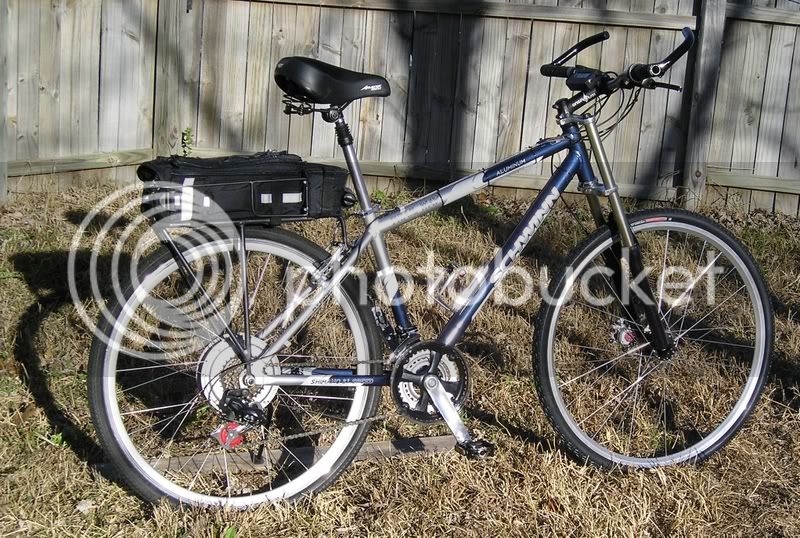I'm now just over 35 miles into this adventure, and have been averaging a hair under 16 Wh/mile so far. This is including some serious hills, one of which saw an indicated draw of 1400+W on the CA at around 8 mph (with me pedaling my heart out simultaneously). Yikes. The CA is set for 35A limit nominally.
I just ordered a centerstand for the bike.
It's sold at Spooky Cycles for $20 USD + $9 shipping. I apologize for the hideous site: doesn't render properly in many browsers and the "header" images for the categories are as big as oatnet's ridiculously large signature image...
:x
The controller has been moved, also. It was originally mounted on the downtube with the upper bottle cage bolt (at its lower end) and a ziptie (at its upper end). Although I stuffed a plastic bag behind the controller, between it and the metal of the downtube itself, I'm sure it would have worn a groove in the paint before long. Furthermore, I was worried about it being stolen, and didn't think it looked particularly good there, what with the arc of wires heading towards it. Finally, it wasn't waterproofed.
Now, after a bit of work, it's living on the left side of the rack. As can be seen in the original image below the Transfer's rear rack is quite nice in that it has a lattice of bars on the sides as well. Originally intended for panniers, they work quite nicely as mounting points. I bought two plates of aluminum about 20mm x 100mm x 4mm at the hardware store, drilled an extra hole to fit the pattern of the Crystalyte controller's preexisting holes in the case, and then sandwiched the rack's side bars between the controller and these plates using 10x24 x 1 inch machine screws, washers, and nylon locking nuts. I realize a picture is worth a thousand words, and I'll get good shots up at some point soonish.
I also made an attempt at waterproofing the controller, since I do live in Seattle, and I plan on using this rig rain or shine throughout the upcoming year. I started with a gallon sized Ziploc bag, and immediately cut off the zipper. Thus "modified" it was then placed like a comically overly-wide controller-condom :lol: , and sealed with that rubber tape that Justin at ebikes.ca apparently throws in with orders. This bag/tape combo had to be penetrated by the mounting hardware as above, but I added an extra turn or two of tape over those areas. If not waterproof, the controller should at least be resistant (provided that my setup doesn't just cause water to pool! perhaps I should put a drain hole in the bottom... time will tell)
Finally, I'm done with the Swagman, and am going to return it to amazon.com tomorrow. The locking mechanism is really quite a joke. I'm also not happy with how sharp-edged the mounting hardware is, as that requires one to add another layer of padding or protection for batteries. The top of the rear rack also simply seems like a poor position for 18 lbs. of batteries. I realize things would be a bit better if I used a slider setup as detailed elsewhere, but the weight would still be pretty far back and very high.
The good news is that the relocation of the controller to the left side of the rear rack now leaves the front triangle open. My plan is to waterproof the battery brick, possibly with giant heatshrink, possibly just with a high quality plastic bag taped at its proximal end. Then I will build a quick-release holder for it. It will run parallel to the downtube, and will use the two bottle cage bolts as attachment points. It'll clearly be metal with some sort of 90 degree "shelf" at the bottom to hold the battery along with side supports, but I haven't decided on what to use to actually secure the battery. Velcro straps seem too insecure for an expensive 18 lb load.
I guess I'll be browsing around the hardware store tomorrow... Fun.

The original image to illustrate the side bars on the rear rack:
















